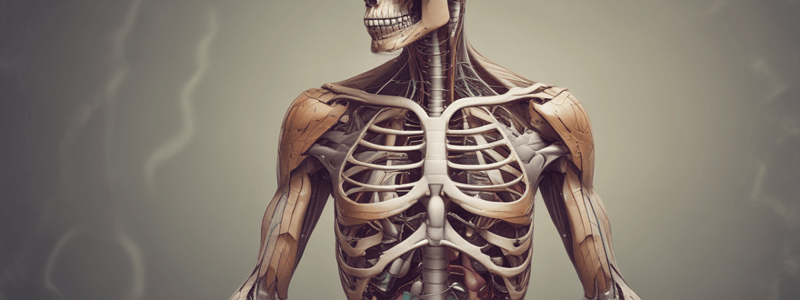Podcast
Questions and Answers
Which muscle helps extend the arm away from the body and rotate the shoulder?
Which muscle helps extend the arm away from the body and rotate the shoulder?
- levator anguli oris
- levator labii superioris
- latissimus dorsi (correct)
- levator palpebrae superioris
What is the primary function of the internal jugular vein?
What is the primary function of the internal jugular vein?
- Collects blood from the brain and parts of the face and neck (correct)
- Supplies blood to the lower back muscles
- Facilitates movement of the upper lip
- Controls the eyelid
What are lacrimal bones, and where are they located?
What are lacrimal bones, and where are they located?
- Encasing bones in the ear
- Muscles that control the eyelid
- Blood vessels in the neck
- Small bones located in the wall of the eye sockets (correct)
What is interstitial fluid?
What is interstitial fluid?
Which muscle surrounds the upper lip?
Which muscle surrounds the upper lip?
Which muscle raises the angle of the mouth and draws it inward?
Which muscle raises the angle of the mouth and draws it inward?
What is the primary function of a joint in the human skeleton?
What is the primary function of a joint in the human skeleton?
What is the term for the connection between two or more bones of the skeleton?
What is the term for the connection between two or more bones of the skeleton?
What is the role of a joint in the human body?
What is the role of a joint in the human body?
What is the definition of a joint in the context of the human skeleton?
What is the definition of a joint in the context of the human skeleton?
What is the purpose of a joint in the skeletal system?
What is the purpose of a joint in the skeletal system?
What is the primary function of the levator palpebrae superior muscle?
What is the primary function of the levator palpebrae superior muscle?
What can be described as a thin muscle that controls the eyelid?
What can be described as a thin muscle that controls the eyelid?
Which of the following muscles is NOT associated with the eye?
Which of the following muscles is NOT associated with the eye?
What is the main action of the levator palpebrae superior muscle?
What is the main action of the levator palpebrae superior muscle?
Which muscle is responsible for opening the eye?
Which muscle is responsible for opening the eye?
Flashcards are hidden until you start studying
Study Notes
Blood Vessels
- The internal jugular vein is located at the side of the neck and collects blood from the brain and parts of the face and neck.
Tissue and Fluid
- Interstitial fluid is blood plasma found in the spaces between tissue cells.
Skeletal System
- A joint is the connection between two or more bones of the skeleton.
- The lacrimal bones are small bones located in the wall of the eye sockets.
Muscles
Back and Shoulder
- The latissimus dorsi is a large, flat, triangular muscle covering the lower back that helps extend the arm away from the body and rotate the shoulder.
Face and Head
- The levator anguli oris muscle raises the angle of the mouth and draws it inward.
- The levator labii superioris muscle surrounds the upper lip.
- The levator palpebrae superioris muscle is a thin muscle that controls the eyelid.
Glossary of Anatomical Terms
- Internal jugular vein: a vein located at the side of the neck that collects blood from the brain and parts of the face and neck.
- Interstitial fluid: blood plasma found in the spaces between tissue cells.
Skeletal System
- Joint: the connection between two or more bones of the skeleton.
- Lacrimal bones: small bones located in the wall of the eye sockets.
Muscular System
- Latissimus dorsi: a large, flat, triangular muscle covering the lower back that helps extend the arm away from the body and rotate the shoulder.
- Levator anguli oris muscle: raises the angle of the mouth and draws it inward.
- Levator labii superioris muscle: surrounds the upper lip.
- Levator palpebrae superioris muscle: a thin muscle that controls the eyelid.
Blood Vessels and Circulation
- The internal jugular vein is located at the side of the neck and collects blood from the brain and parts of the face and neck.
- Interstitial fluid is blood plasma found in the spaces between tissue cells.
Skeletal System
- A joint is the connection between two or more bones of the skeleton.
- The lacrimal bones are small bones located in the wall of the eye sockets.
Muscular System
- The latissimus dorsi is a large, flat, triangular muscle that covers the lower back and helps extend the arm away from the body and rotate the shoulder.
- The levator anguli oris muscle raises the angle of the mouth and draws it inward.
- The levator labii superioris muscle surrounds the upper lip.
- The levator palpebrae superioris muscle is a thin muscle that controls the eyelid.
Studying That Suits You
Use AI to generate personalized quizzes and flashcards to suit your learning preferences.




